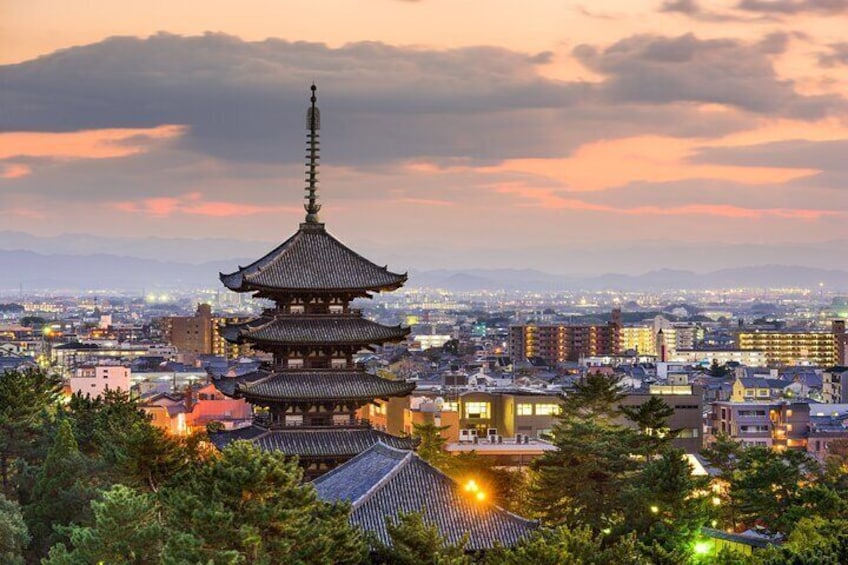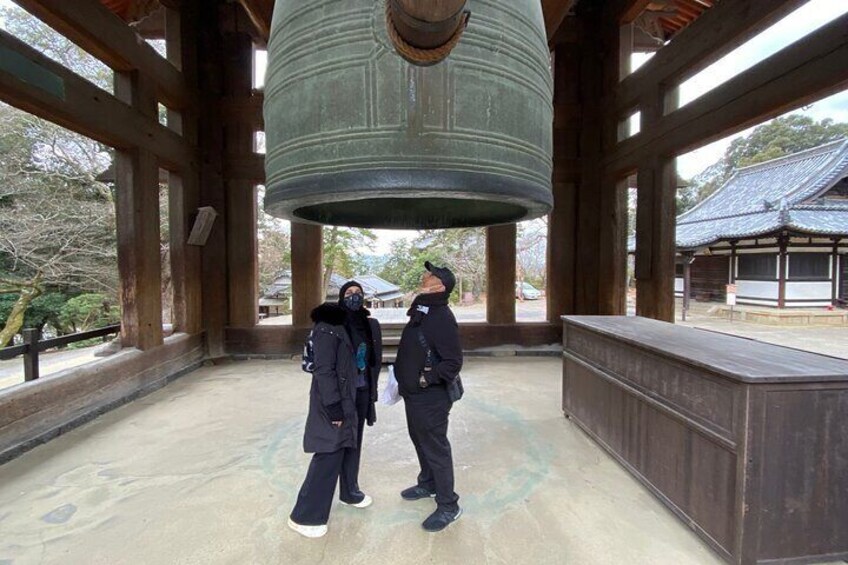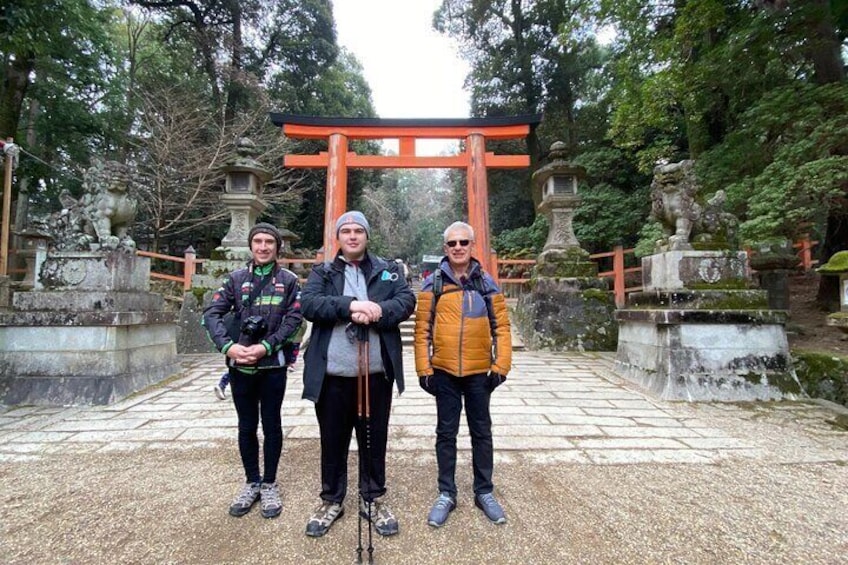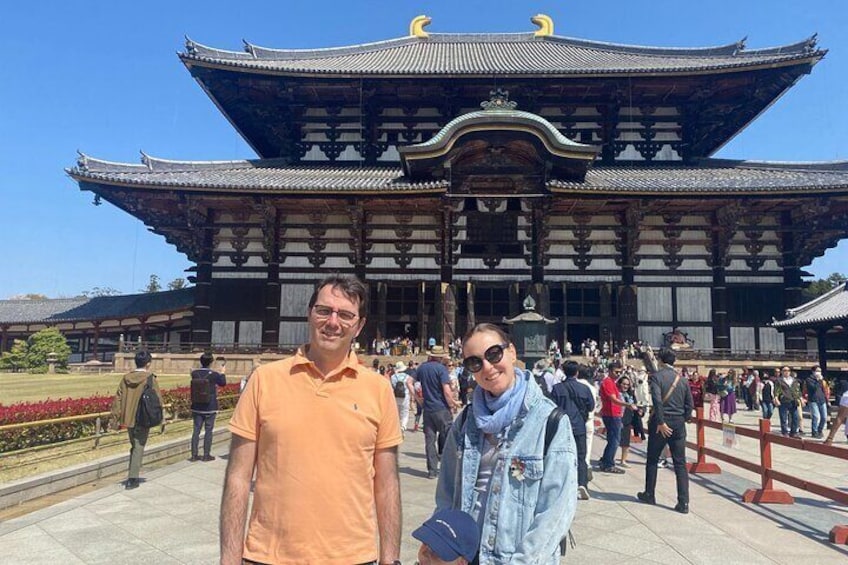List your propertySupportTrips Learn about Expedia Rewards
Learn about Expedia Rewards
Members save 10% or more on over 100,000 hotels worldwide when you’re signed in





Private Tour to Nara from Osaka with English speaking Driver
By Japan Guide Agency
10/10
10 out of 10Free cancellation available
per traveller*
*Get a lower price by selecting multiple travellers
Features
- Free cancellation available
- 8h
- Mobile voucher
- Instant confirmation
- Selective hotel pickup
Overview
This is the ideal plan for independent travellers that want to discover Nara’s highlights on their own, but would like the comfort and ease of travelling in a private vehicle. Avoid the potential confusion of public transport system and relax while your English-speaking chauffeur takes the wheel.
Nara's proximity to Osaka, and its rich collection of traditional sites, make it an ideal destination for a day trip from Osaka. You can visit the beautiful temples of this ancient Japanese city and meet the friendly deer that are sacred to the area.
Activity location
- Todai-ji Temple
- 406-1 Zoushi-cho,
- 630-8587, Nara, Nara Prefecture, Japan
Meeting/Redemption Point
- Todai-ji Temple
- 406-1 Zoushi-cho,
- 630-8587, Nara, Nara Prefecture, Japan
Check availability
Minivan(for 5 PAX or less)
- 8h
Minivan(for 5 PAX or less) : Sun, Mon, Tue, Wed, Thu, Fri, Sat
8:00am, 8:30am, 9:00am, 9:30am, 10:00am, 10:30am, 11:00am
Vehicle: ¥80,600
Pickup included
Price details
AU$1,215.65 x 1 TravellerAU$1,215.65
Total
* Select 5 traveller tickets to get our lowest price of AU$243.13 per traveller
Until Mon, 6 May
What's included, what's not
- Private transport
- English Speaking Driver
- Highway fees, Fuel, Parking Fees
- Air-conditioned vehicle
- Any other personal expenses
- Food and Drink (for yourself)
- You cannot combine tour groups
Know before you book
- Specialised infant seats are available
- Service animals allowed
- Infants and small children can ride in a pram or stroller
- Suitable for all physical fitness levels
- Transport options are wheelchair accessible
- Wheelchair accessible
Activity itinerary
Todai-ji Temple
- 1h
Todaiji (東大寺, Tōdaiji, "Great Eastern Temple") is one of Japan's most famous and historically significant temples and a landmark of Nara. The temple was constructed in 752 as the head temple of all provincial Buddhist temples of Japan and grew so powerful that the capital was moved from Nara to Nagaoka in 784 in order to lower the temple's influence on government affairs.
Until recently, Todaiji's main hall, the Daibutsuden (Big Buddha Hall), held the record as the world's largest wooden building, despite the fact that the present reconstruction of 1692 is only two thirds of the original temple hall's size. The massive building houses one of Japan's largest bronze statues of Buddha (Daibutsu). The 15 metres tall, seated Buddha represents Vairocana and is flanked by two Bodhisattvas.
Nara Park
- 20m
Nara Park (奈良公園, Nara Kōen) is a large park in central Nara. Established in 1880, it is the location of many of Nara's main attractions including Todaiji, Kasuga Taisha, Kofukuji and the Nara National Museum. It is also home to hundreds of freely roaming deer.
Kasuga Taisha
- 1h
Kasuga Taisha (春日大社) is Nara's most celebrated shrine. It was established at the same time as the capital and is dedicated to the deity responsible for the protection of the city. Kasuga Taisha was also the tutelary shrine of the Fujiwara, Japan's most powerful family clan during most of the Nara and Heian Periods. Like the Ise Shrines, Kasuga Taisha had been periodically rebuilt every 20 years for many centuries. In the case of Kasuga Taisha, however, the custom was discontinued at the end of the Edo Period.
Beyond the shrine's offering hall, which can be visited free of charge, there is a paid inner area which provides a closer view of the shrine's inner buildings. Furthest in is the main sanctuary, containing multiple shrine buildings that display the distinctive Kasuga style of shrine architecture, characterised by a sloping roof extending over the front of the building.
Wakakusayama Hill
- 20m
Mount Wakakusayama (若草山) is the grass covered mountain behind Nara Park, located between Todaiji Temple and Kasuga Shrine. The mountain is about 350 metres tall and affords unobstructed views over Nara City. Tourists are allowed to climb Mount Wakakusayama all year round except during winter. A small entrance fee is charged.
The grassy slope of the mountain is lined by cherry trees that are usually in full bloom around early April. A steep trail leads along the leftmost edge of the slope to a plateau halfway up the mountain with great views over the city. It takes about 15-20 minutes to reach the plateau and many people do not hike farther. An additional 20-30 minutes would get you to the mountain's peak.
Horyu-ji Temple
- 1h
Horyuji Temple (法隆寺, Hōryūji) was founded in 607 by Prince Shotoku, who is credited with the early promotion of Buddhism in Japan. Horyuji is one of the country's oldest temples and contains the world's oldest surviving wooden structures. It was designated a world heritage site in 1993. Horyuji's temple grounds are spacious and separated into two main precincts, the Western Precinct (Saiin Garan) and the Eastern Precinct (Toin Garan).
Naramachi
- 20m
Naramachi (奈良町, literally "Nara Town") is the former merchant district of Nara, where several traditional residential buildings and warehouses are preserved and open to the public. Boutiques, shops, cafes, restaurants and a few museums now line the district's narrow lanes.
Many of Naramachi's buildings in the Edo Period and earlier were machiya, long, narrow "townhouses" that served both as shops and as the living quarters of the local merchants. The store fronts of machiya were often kept narrow in order to save on taxes, which used to be calculated on a property's street access rather than its total area. Today, a handful of machiya have been preserved and made open to the public as museums.
Kofuku-ji Temple
- 30m
Kofukuji (興福寺, Kōfukuji) used to be the family temple of the Fujiwara, the most powerful aristocratic clan during much of the Nara and Heian Periods. The temple was established in Nara at the same time as the capital in 710. At the height of Fujiwara power, the temple consisted of over 150 buildings.
The temple features several buildings of great historic value, including a five-storied pagoda and a three-storied pagoda. At 50 metres, the five-storied pagoda is Japan's second tallest wooden pagoda, just seven metres shorter than the five-storied pagoda at Kyoto's Toji Temple. Kofukuji's pagoda is both a landmark and symbol of Nara. It was first built in 730, and was most recently rebuilt in 1426. Neither pagoda can be entered by the public.
Yakushiji Temple
- 30m
Yakushiji (薬師寺) was constructed by Emperor Tenmu in the late 7th century for the recovery of the emperor's sick wife. One of Japan's oldest temples, Yakushiji has a strictly symmetric layout, with the main hall and lecture hall standing on a central axis, flanked by two pagodas.
The main hall was rebuilt in the 1970s after being destroyed by fire and houses a Yakushi trinity, a masterpiece of Japanese Buddhist art. The East Pagoda is the temple's only structure to have survived the many fires that have beset the temple over the years, and dates from 730. It appears to have six stories, but is in fact only truly three-storied, like the West Pagoda.
Shinyakushiji Temple
- 20m
Shin-Yakushiji Temple (新薬師寺) was founded during the Nara Period (710-794) by an empress for the sake of the ailing emperor. It is devoted to Yakushi Buddha, the patron of medicine in Japanese Buddhism. Shin-Yakushiji means "New Yakushi Temple", because there already existed a Yakushiji Temple. During its heyday, Shin-Yakushiji consisted of a large complex of buildings, but all except for the main hall (Hondo) have since been lost.
Inside the main hall there are life size statues of 12 guardian deities surrounding a two metre tall statue of a seated Yakushi Buddha, which are the temple's main objects of worship. The Yakushi statue is made of wood while the guardians are made of clay. Each guardian has a different character and possesses a different weapon, and visitors can spend quite a while admiring them. There are also a few small paths around the temple grounds.
Nara National Museum
- 30m
The Nara National Museum (奈良国立博物館, Nara Kokuritsu Hakubutsukan), located in Nara Park, is an art museum which primarily displays Japanese Buddhist art. Established in 1889, the museum retains its original building and is joined by a new wing that is connected to the original building by an underground passage.
Both wings display the museum's permanent collection, which includes Buddhist statues, paintings, scrolls and ceremonial objects mainly from Japan. The new wing also houses temporary exhibitions, including an annual exhibition every autumn of treasures from Todaiji Temple. A ticket to the museum gives access to both wings, and English explanations are available throughout the museum.
Heijō Palace Site Historical Park
- 1h
During most of the Nara Period (710-794), Nara served as the capital of Japan and was known as Heijo-kyo. The Heijo Palace extended about one kilometre wide and one kilometre long and served as the site of the emperor's residence and government offices. For its great historical and cultural importance, the palace site is included as one of the UNESCO World Heritage Sites of Nara.
Toshodai-ji Temple
- 30m
Toshodaiji (唐招提寺, Tōshōdaiji) was founded in the year 759 by Ganjin, a Chinese priest who was invited to Japan by the emperor in order to train priests and improve Japanese Buddhism. Ganjin's influence in the introduction of Buddhism to Japan was monumental, and his arrival and teaching at Toshodaiji (which roughly translates to "temple of the one invited from Tang China") were important stages in that process.
Toshodaiji's main hall (kondo) was re-opened in late 2009 after being renovated over a period of almost ten years, during which the building was dismantled and reconstructed. The temple's lecture hall (kodo) was originally an administrative building located in the Nara Imperial Palace and was later moved to Toshodaiji. Today, it is the only surviving building of the former palace.
Isuien Garden
- 20m
Isuien (依水園) is an attractive Japanese garden with a variety of features, such as the use of Todaiji Temple's Nandaimon Gate and Mount Wakakusayama as "borrowed scenery". Isuien means "garden founded on water", and the garden's name is derived from the fact that its ponds are fed by the small adjacent Yoshikigawa River. The Yoshikien Garden is located just on the other side of the river.
Yoshikien
- 20m
Yoshikien (吉城園) is a pleasant Japanese garden located in central Nara. It is named after the Yoshikigawa River, a small river that runs beside the garden, and was built on the site of Kofukuji Temple's former priest residences. The entry fee to the garden is waived for foreign tourists.
There are three unique gardens within Yoshikien: a pond garden, a moss garden and a tea ceremony garden. So, a visit to Yoshikien provides the opportunity to see three different variations of Japanese gardens in one spot. If visitors still want to see more techniques of Japanese gardening, the Isuien Garden is located just across the small river.
Location
Activity location
- Todai-ji Temple
- 406-1 Zoushi-cho,
- 630-8587, Nara, Nara Prefecture, Japan
Meeting/Redemption Point
- Todai-ji Temple
- 406-1 Zoushi-cho,
- 630-8587, Nara, Nara Prefecture, Japan
Best Deals on Things to Do
Experience the wonders of the world up close with great deals on things to do near and far. Expedia offers one-of-a-kind activities that allow you to explore Nara your way. Whether you love nature, culture, food or a bit of adventure, we have the perfect activity for you.
Top experiences in Nara
With so many activities in Nara, planning the perfect day out may seem like a daunting task. Expedia is here to take the hassle out of finding the best attractions, tours and activities in Nara. Families, couples and business travellers can all find the perfect activity in Nara to create life-long memories with the help of Expedia.